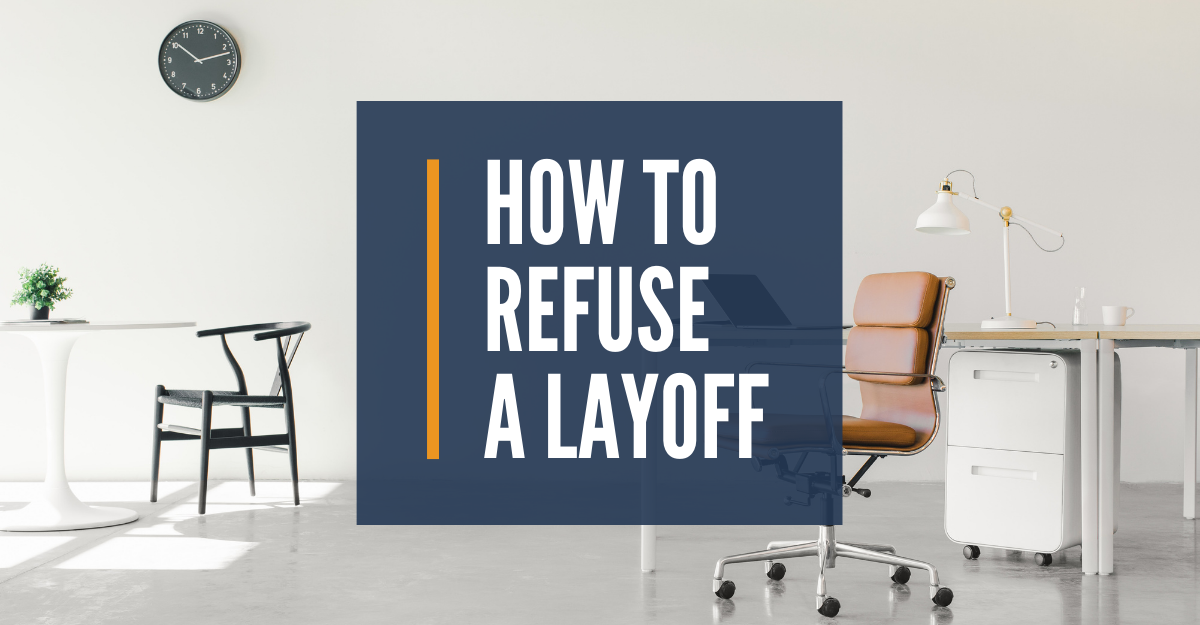How to refuse a layoff: 5 important tips

Being placed on a temporary layoff without your consent and without any contractual terms allowing your employer to do so, amounts to a constructive dismissal. If you are constructively dismissed, you are entitled to a severance package which will be based on age, length of service and the nature of your position.
All this being said, if your employer tells you that you are going to be placed on a layoff, is there anything you can do about it? Yes – and you should do something about it!
In this blog, I will let you know exactly what steps to take to protect your legal position.
1. Understand the terms of your employment contract
Ideally, you would have an understanding of your employment contract before starting work, but that is rarely the case. If you have not looked at your employment contract since you started working, I highly recommend that you locate the document, and read it with a fine-tooth comb.
You need to look for any terms that allow the employer to place you on a temporary layoff. If you are having trouble locating the terms, or do not understand the terms, one of our lawyers or paralegals would be happy to book a consultation with you. If those terms do exist, we can tell you whether or not that clause is binding.
Once you have confirmed that there are no terms allowing your employer to place you on a layoff, proceed to the next step.
2. Decide how you want to approach the layoff
In some circumstances, it may make sense, based on your own personal situation or professional history to remain with an employer even if they have placed you on a temporary layoff.
For example, maybe you are getting laid off from your “dream job,” and do not want to burn a bridge with your employer by claiming constructive dismissal. Ultimately, the result of claiming this type of dismissal is that you are agreeing that your employment will come to an end. This may not be the best option for some people.
3. Talk to your employer
If you are prepared to end your employment, claim constructive dismissal and pursue your full severance entitlements, have a verbal conversation with your employer at the time that you are presented with a layoff. Tell them that you understand that the terms of your employment do not allow your employer to place you on a layoff, and that if your employer is going to force you not to come to work, that you will claim constructive dismissal and pursue your full severance entitlements.
4. Get it in writing
Immediately after the oral conversation, tell your employer in writing through an email or a letter the following:
On (insert date), you told me (insert how they told you; by email, by letter, in person, etc.) that I would be placed on a temporary layoff. In accordance with what I said to you orally on (insert date), namely, that my employment contract does not give you the right to place me on a temporary layoff, I will not be accepting the temporary layoff. Please let me know as soon as possible, and by no later than the next business day, whether or not I can report to work. If the answer is that I am not allowed to report to work, please explain to me the reasons why in writing. If the reason is that I have been placed on a temporary layoff, it is imperative that I let you know that I do not consent to being placed on a temporary layoff as the terms of my employment contract do not give you the right to do so. As such, should you maintain that I am forced to accept this temporary layoff, I will be claiming that I have been constructively dismissed and will pursue my full severance entitlements.
5. Negotiate your severance package
Find out how much severance pay you are owed by using the Severance Pay Calculator.
Contact our team immediately to ensure that you secure a full severance package tailored to your unique situation, and that takes into account factors like your time with the company, age, position and salary. It is vital that you get a complete understanding of how much compensation you are owed. Our years of experience in Ontario, Alberta and British Columbia has shown us that employers consistently offer inadequate severance packages that fail to come close to what terminated individuals are actually owed.
I accepted a layoff in the past. Can I refuse another layoff?
You may have given up your right to refuse a future layoff if you accepted one in the past. Giving your employer the right to place you on a temporary layoff once may set a precedent, allowing them to do so again, and rob you of the ability to claim constructive dismissal.
If you did agree to a past layoff, but do not wish to accept another pause in employment, contact us as soon as possible so that we can review your situation to determine if the option to pursue a severance package still exists.




